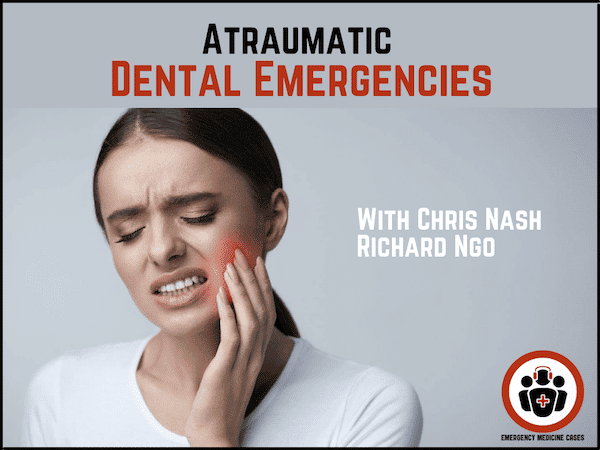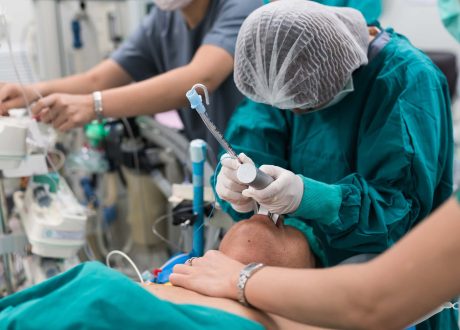Podcast: Play in new window | Download
“This learning material is sourced from Emergency Medicine Cases and has been published
here with permission as per creative commons copyright”
Here’s the problem: About 1% of all visits to the ED are for dental complaints, yet most of us have little training on how to recognize and manage dental emergencies. There are a multitude of reasons to explain the hoards of dental patients showing up in our EDs, not to mention the cost of seeing a dentist. Regardless, we need to know how to recognize and manage dental emergencies to best take care of our patients. After some suggestions from listeners and various colleagues to do an episode on dental emergencies, and learning more about dental emergencies myself, I realized, that the simple algorithm I apply to most patients I see in the ED with atraumatic dental pain – doesn’t look like deep space infection or something I can drain -> analgesics + antibiotics -> send to dentist, was inadequate. In this Part 1 of our 2-part podcast series on dental emergencies, with the help of Dr. Chris Nash and Dr. Richard Ngo, we tackle these atraumatic dental emergencies: infections ranging from dental caries to pulpitis and gingivitis to dental abscess, cellulitis and deep space infection, as well as acute necrotizing gingivitis, pericoronitis and dry socket. These all have specific clinical characteristics and require specific management…
Podcast production, sound design & editing by Anton Helman; voice editing by Braedon Paul.
Background research by Ronak Saluja & Ryan O’Reilly
Written Summary and blog post by Anton Helman August, 2023
Cite this podcast as: Helman, A. Ngo, R. Nash, R. Atraumatic Dental Emergencies. Emergency Medicine Cases. August, 2023. https://emergencymedicinecases.com/atraumatic-dental-emergencies. Accessed September 14, 2023
Dental infections
Progression of dental infections in dental emergencies
It is important to understand the usual progression of dental infections as the management changes as the infection progresses. Simple dental anatomy helps to understand this progression.

Dental anatomy
Dental cary: a bacterial disease of teeth that demineralizes tooth enamel and dentine by acid produced during the fermentation of dietary carbohydrates by oral bacteria. It is characterized by loss of enamel and discoloration of the tooth.

Simple dental cary characterized by loss of enamel and discoloration
Pulpitis: inflammation of the tooth pulp caused by a cary encroaching the pulp.
Gingivitis: inflammation of the gingiva (gum adjacent to the tooth) caused by plaque on tooth surface
| Dental condition | Clinical characteristics | Management |
|---|---|---|
| Simple dental cary |
|
Dental hygiene (brushing with flouride, flossing etc)
*no antibiotics required |
| Pulpitis |
|
Analgesics, if severe, urgent referral to dentist removal of the cary, dental restoration or filling
*no antibiotics required |
| Gingivitis |
|
Dental hygiene
*no antibiotics required except for Acute Necrotizing Gingivitis (see below) |
| Dental abscess/cellulitis |
|
I&D if buccal or vestibular location; referral to dentist/oral surgeon for I&D if other location; antibiotics are generally recommended for periodontal abscess (some experts recommend antibiotics only if abscess is associated with cellulitis); most guidelines suggest that there is no role for antibiotics for uncomplicated periapical abscesses |
| Deep space infection
(including Ludwig’s Angina & septic cerebral venous thrombosis) |
2 physical findings that suggest deep space infection and the need to obtain a CT: 1. Blunting of the inferior border of the mandible at the body 2. Trismus <2.5cm of maximum mouth opening
|
Ludwig’s angina – Quick Hits 5 |
Pearl: Pulpitis can be differentiated from a periapical abscess by considering the duration of the pain and secondary signs such as tooth elevation, swelling, adjacent cellulitis and lymphadenopathy.
Pitfall: avoid the mental nerve when incising when I&D of anterior mandibular abscess
Mental nerve surface anatomy to be avoided in I&D of anterior mandibular dental abscess
Pearl: 2 physical findings that strongly suggest deep space infection and the need to obtain a CT scan: Blunting of the inferior border of the mandible at the body and trismus <2.5cm of maximum mouth opening
Pearl: abscesses outside of the vestibular area (space between the front teeth and the lips forms the anterior part of the oral vestibule) or buccal space are best left to specialists.
Inferior alveolar nerve block for dental pain
Supraperiosteal nerve block for dental pain
Antibiotics are overused in the ED for dental pain in dental emergencies
Observational data suggest that antibiotics are over-prescribed for dental pain. It is important to understand that simple dental caries, pulpitis and gingivitis generally do not require antibiotics. While antibiotics are generally prescribed for dental abscess, there is little evidence that this practice is beneficial unless there is an associated cellulitis or deep space infection.
Antibiotic suggestions for dental infections (cellulitis, abscess, deep space infections)
- First line: Clindamycin 300mg po q8h or Penicillin VK 250-500mg po q6h
- If severe infection then consider Amoxicillin/Clavulinic acid 875/125 q12h or add metronidazole 500mg po q8h to first line
- Complicated/systemic infection– Piperacillin/tazobactam or Clindamycin + Ceftriaxone
Pitfall: The most common pitfall in the ED management of atraumatic dental emergencies is the overuse of antibiotics and over-coverage when using antibiotics. Dental caries, pulpitis and gingivitis do not require antibiotic treatment unless they are complicated by cellulitis, abscess or deep space infection. Penicillin, Amoxicillin or Clindamycin are recommended first line agents for simple dental infections. If the infection is severe, consider adding metronidazole or else Amoxicillin-Clavulinic acid, and for systemically ill patients with complicated infection consider Piperacillin-tazobactam or Clindamycin plus Ceftriaxone.
Acute necrotizing gingivitis – a special type of gingivitis in dental emergencies
Another of the important dental emergencies is Acute necrotizing gingivitis, otherwise known as “trench mouth” – as World War 1 soldiers in the trenches suffered this disease as a result of prolonged poor dental hygiene. It is characterized by painful, swollen, bleeding gums and ulceration of inter-dental papillae (ulcers between the teeth) and should be suspected in patients with a known immunocompromising state with painful bleeding gums. If this dental emergencies diagnosis is made in the ED, HIV testing should be considered.

Acute necrotizing gingivitis with swollen gingiva and ulcers in between the teeth
Management of acute necrotizing gingivitis
- NSAIDs, antibiotics
- Amoxicillin 500 mg PO q8h + metronidazole 500 mg PO q8h x 10 d or Clindamycin 300 mg PO q8h × 10 d
- Referral to dentist or oral surgeon to debride gingiva
- Chlorhexidine 15 mL oral rinse and expectorate q12h for 7-10 d
- Ensure good oral hygiene with warm water rinses
- Provide IV hydration/enteral nutrition as indicated
Pericoronitis – another special type of gingivitis dental emergency
sPericoronitis is inflammation of the gum surrounding the crown of a partially erupted tooth, most commonly a wisdom tooth. Food gets caught under the flap of gum covering the tooth. Pus may ooze from the flap. Pericoronitis may be complicated by cellulitis, abscess and trismus, and may rarely progress to airway compromise if left untreated.

Pericoronitis (care of academic Life in EM) https://www.aliem.com/smiler-104/
Management includes irrigation under the gum flap with saline which resolves pain within minutes, and saltwater mouthwashes. Antibiotics are reserved for pericoronitis that is complicated by cellulitis or abscess. Urgent referral to a dentist for consideration of tooth extraction is prudent.
Pearl: saline irrigation of suspected pericoronitis resulting in resolution of pain within minutes confirms the diagnosis
Dry socket – the most common post-tooth extraction complication
Dry socket typically occurs 3-5 days after tooth extraction when the clot dislodges and exposes the bone and nerve causing pain. There is little to see on exam. Dry socket should be irrigated with saline, gently suctioned taking care not to dislodge any blood clot that might be developing, and then placement of a medicated dry socket dressing – usually iodoform gauze. Curetting should be avoided so as not to dislodge any clot that may be forming in the socket. Patients with dry socket should be followed up by a dentist or oral surgeon in 2 days.
Pitfall: Curreting a dry socket is a common pitfall. Curetting should be avoided as it may dislodge a developing clot that protects the socket and diminishes pain.










